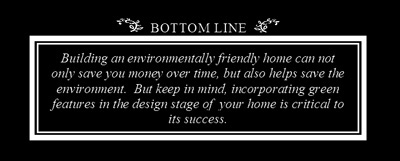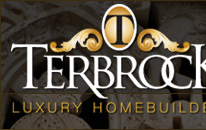|

Steve
Terbrock, CGP
Steve
Terbrock has successfully completed the Certified Green Professional
(CGP) program through the NAHB. Please see links below for details.
http://www.nahbgreen.org/
http://www.nahb.org/category.aspx?sectionID=1174

Today
many builders and home buyers are concerned about preserving the
environment. With increased attention on the condition of our planet,
'Green Building' has become a sought after choice for homeowners.
In its simplest terms, green building is making your home more environmentally
friendly. It means increasing your home's efficiency so it makes
better use of things like water, energy, temperature control, and
construction materials. It's about using resources effectively so
you reduce the impact of your home on the environment. Many people
are already familiar with these basic tenants of green building.
But what does green building mean for you? Is the only difference
between a green home and a non-green home the energy bills? What
people are less familiar with is what green building has to offer
with regards to their daily lifestyle and comfortability as well
as their health and wellness. For example, enhanced indoor air quality.
Green building seeks to reduce volatile organic compounds, or VOC's,
and other air impurities such as microbial contaminants and allergens.
Another example is thermal comfort. A properly designed HVAC system
coupled with a properly designed building envelope will increase
the occupants' thermal comfort by reducing temperature and humidity
fluctuations associated with older technologies. Green building
can also improve the luminous environment through the careful integration
of natural and artificial light. Yet another positive is sound control.
Careful selection of materials and assemblies with an emphasis on
reducing sound transmissions can create a quiet, pleasurable living
environment. The list goes on.
While building an environmentally friendly home sounds good to most
people, they usually want to know two things: what can I do and
how much will it cost me? Let's address the last question first.
You may have heard that building green is more expensive. While
that may be true in some instances, it doesn't have to be. In today's
market some elements of green building can cost more initially,
but many do not, and some even less. Factor in energy savings over
time and increased durability of many of the green building products,
and any additional up-front cost become much easier to justify.
If you intend to live in your home for a substantial amount of time
(i.e. your final build), the more seriously one should consider
the green investment. One should also look into the available tax
and private incentives that will be available at the time you begin
construction. Another potential cost to consider is green certification
of your home. For some people it is important that their home is
'Certified' green. The only way to do this, is to get it independently
verified. Some programs are more nationally recognized than others.
One example of a nationally recognized certification program is
LEED Certification. Depending on the program selected, the fees
for this type of certification can range from hundreds to many thousands
of dollars. One should look to their builder and the internet to
decide if and what certification is right for you.
To
answer the first question, let's take a look at a few things you
can do to make your new home more environmentally friendly.
HEATING AND COOLING EQUIPMENT: One of the most important
things you can do to make your home more 'green' is to carefully
consider your choice of heating and cooling equipment. The heating/air
conditioning system should be built and installed with the highest
AFUE (Annual Fuel Utilization Efficiency) rating for the furnace
and SEER (Seasonal Energy Efficiency Ratio) rating for the condenser
unit possible. The greater the AFUE and SEER ratings, the more energy
efficient your unit will be.
The system should also be sized appropriately to effectively cool
or heat your home without being oversized. In fact, it is often
better to err on the side of being undersized by half a ton than
oversized. (Note: A 'ton' is a unit of energy used to measure output.
Typically you need about one ton of output for every 400 square
feet of your home.) Many builders don't recommend that you oversize
the tonnage of your home's AC system. The most efficient homes often
run on a system designed to be 10 percent smaller than typical installations.
A good air system should also be installed with as few bends and
connections in the duct work as possible to maximize air volume
and to minimize the risk of gaps and voids.
Another choice of HVAC equipment that can be considered is a Geothermal
Furnace. A geothermal furnace is a heat pump that uses water instead
of air as a source of heat gain or loss. Water is pumped through
a closed loop of pipes buried in the ground. The condenser and evaporator
coil are enclosed in one cabinet therefore eliminating the need
for an outside condenser unit. In heating mode, heat is extracted
from the evaporator coil and released into water through the condenser.
In cooling mode, the operation is reversed. The operating cost of
a geothermal system is lower than that of a typical forced air system
but the set up cost is higher.
Yet another alternative when considering how to heat your house
is a Radiant Heat System. A radiant heat system consists of a heat
source, most often encapsulated in concrete, installed below your
finished flooring. The heat source can be either electric heating
coils or a hot water loop. A radiant heat system still requires
that a forced air system is installed to provide cooling. The operating
cost of the radiant heat system, when in heat mode, are lower than
that of a typical forced air system but the set up cost is higher.
The options as to how to heat and cool your new luxury home are
numerous and always changing. One should discuss with their builder,
in conjunction with a local heating and cooling professional, the
options and pricing specific to the area you intend to build.
INSULATION: A well
insulated home requires not only high quality materials, but also
that the material is installed properly. Special care needs to be
taken to make sure all penetration points are filled and that the
HVAC system duct work is insulated and air tight.
If it's within your budget, one great option is to have your home
insulated with a blown-in product as opposed to batt insulation.
On top of the good R-values (a term used to measure how well insulation
resists the flow of heat or cold through it) blown-in insulation
can fill cracks and crevices in ways that traditional batt insulation
can't. If a blown-in product can't be used, great care should be
exercised to make sure the insulation is installed to eliminate
as many gaps and penetrations as possible.
Another form of insulation gaining popularity is spray-in foam insulation.
It is very much like the canned product found at a local hardware
store. The spray-in foam is particularly useful where traditional
insulations have difficulty such as at the perimeter band boards
and sill plates of subfloor structures.
HOME ORIENTATION: To reduce energy loads, it's important
to design and position the house in such a way as to minimize exposure
to the hot sun in the summer, while taking advantage of the suns
solar energy in the winter. Whenever possible, the front door or
the house's longest wall should be set to within 5 degrees of true
south. It may also be important to landscape in such a way to create
wind breaks for the home or create shade to increase efficiency.
Good window placement can increase natural light while reducing
the need for electric lighting.
WINDOWS AND DOORS: Windows help make a home beautiful, but
they can also waste a lot of energy if they let in heat in the summer,
cold in the winter, and drafts anytime. To get more energy-efficient
windows, select ones with good insulation values. Some have special
coatings that can help repel heat. Others are double or triple paned
which helps insulation. Some energy-efficient windows have non-toxic
gas between the panes such as argon or krypton that provide better
insulation than air. Even the window frames can affect how efficient
they are. For example, aluminum frames typically provide the lowest
insulation value. Wood, vinyl, and fiberglass are better. Warm-edge
spacers are even better. Certain window coverings like reflective
blinds and shades can also generate incredible savings on energy
usage.
When it comes to doors, make sure they have a tight fit and use
excellent weather stripping. Some new door frames include a magnetic
strip that creates a tighter seal and reduces the amount of air
that leaks out. Some of the best core materials for a door include
fiberglass and foam. If a door has glass, it will be more energy
efficient if double or triple paned insulating glass is used.
ROOFING AND EXTERIOR PAINT: Consider using reflective roofing
and lighter exterior paint colors. These two items offer a cooler
home by reflecting the sun's rays rather than absorbing them. Roof
choices and lighter paint colors can create double digit drops in
exterior surface temperatures which can result in greater energy
savings.
BUILDING MATERIALS: Choose to use 'earth-friendly' products
and building materials whenever possible. Typically, these include:
-
Products made with recycled content
- Products that conserve natural resources
- Products that avoid toxic emissions
- Products that are rapidly renewable such as bamboo, cork and straw
- Products with superior durability
WATER SYSTEMS: Consider installing tankless and 'point-of
use' water heating systems. These systems do away with the traditional
standing hot water tanks and more efficiently heat water for the
home. They are also more cost effective.
APPLIANCES: Consider installing 'Energy Star' rated appliances.
Energy Star is a program backed by the government that identifies
products with high energy efficiency. These products often last
longer and are more economical to operate than non-Energy Star rated
appliances.

|











![]()


